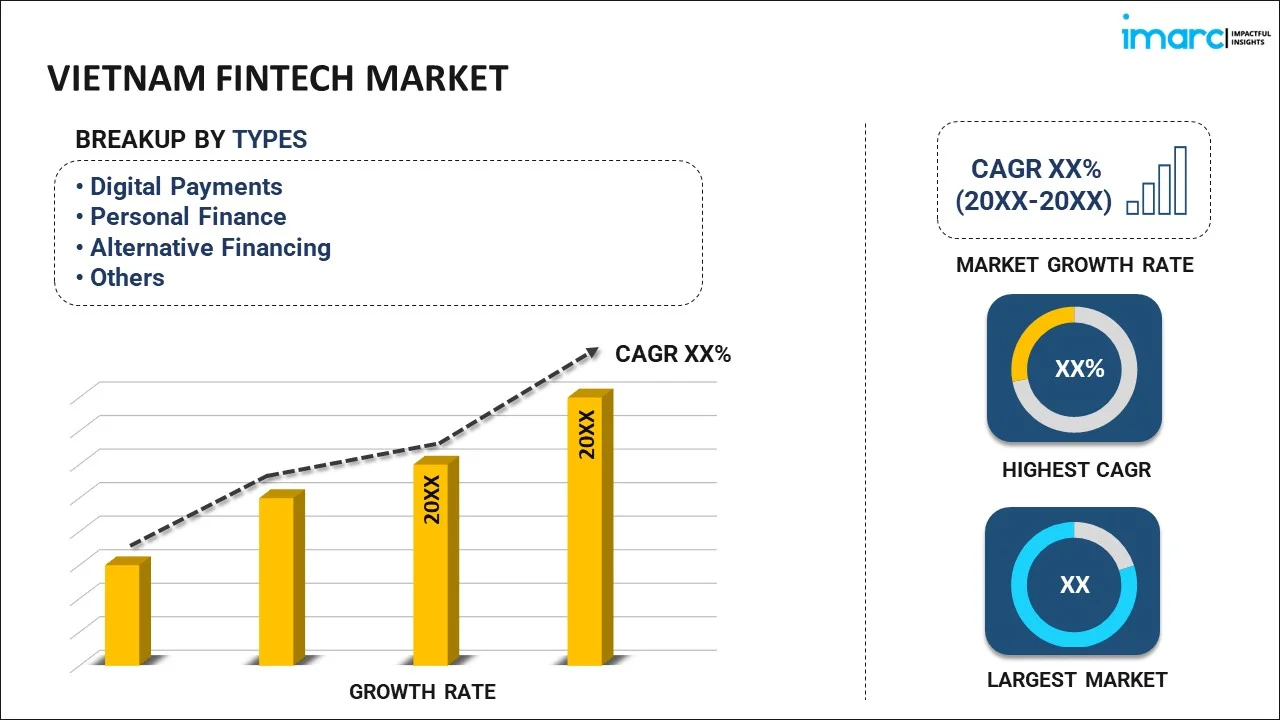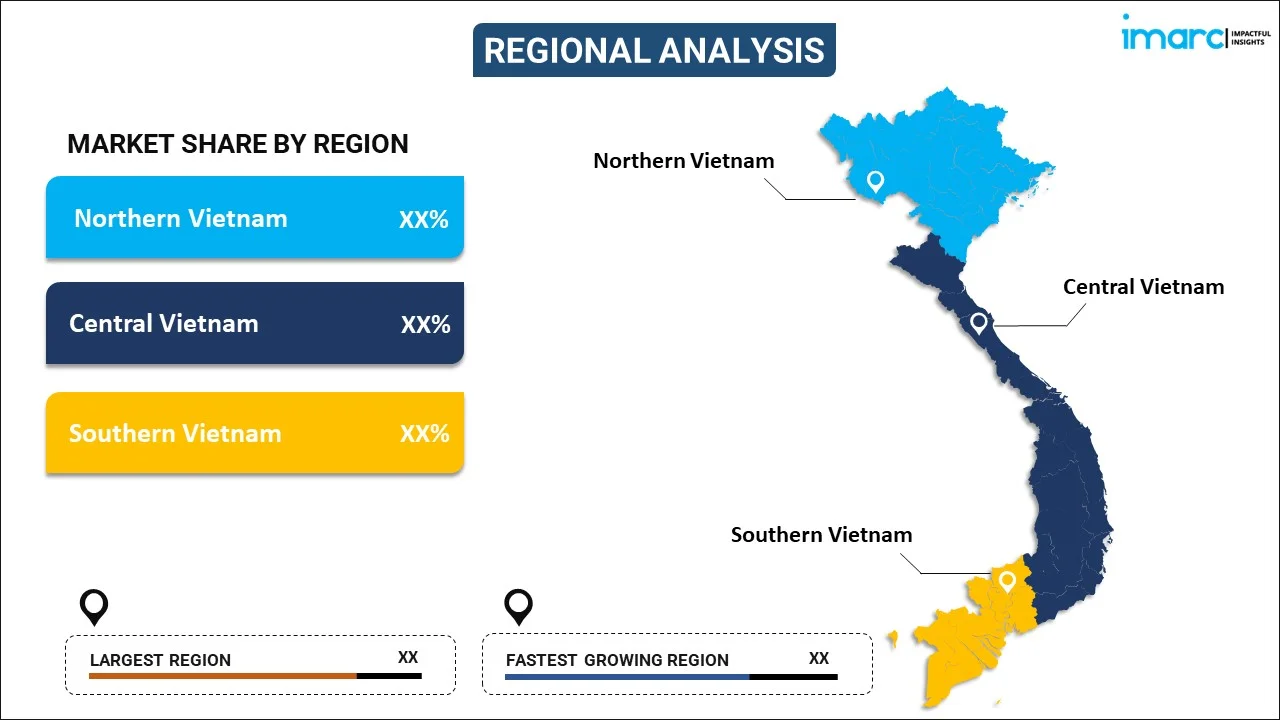
Vietnam Fintech Market Report by Type (Digital Payments, Personal Finance, Alternative Financing, Insurtech, B2C Financial Services Market Places, E-Commerce Purchase Financing, and Others), and Region 2025-2033
Market Overview:
Vietnam fintech market size reached USD 16.9 Billion in 2024. Looking forward, IMARC Group expects the market to reach USD 62.7 Billion by 2033, exhibiting a growth rate (CAGR) of 14.2% during 2025-2033. The rapid digital transformation, the increasing demand for user-friendly financial solutions, the rising integration of data analytics and artificial intelligence, the regulatory changes and open banking, and the growing investment from venture capitalists are some of the key factors driving the market.
|
Report Attribute
|
Key Statistics
|
|---|---|
|
Base Year
|
2024 |
|
Forecast Years
|
2025-2033
|
|
Historical Years
|
2019-2024
|
| Market Size in 2024 | USD 16.9 Billion |
| Market Forecast in 2033 | USD 62.7 Billion |
| Market Growth Rate (2025-2033) | 14.2% |
Fintech, short for "financial technology," is a dynamic and disruptive sector that revolutionizes how financial services are delivered, accessed, and managed through innovative technology. It encompasses various financial solutions, from digital payments and mobile banking to peer-to-peer lending, robo-advisors, blockchain-based cryptocurrencies, and beyond. Fintech companies leverage cutting-edge technologies like artificial intelligence, big data analytics, cloud computing, and blockchain to create efficient, secure, and user-friendly financial products and services. These innovations empower consumers, businesses, and even traditionally underserved populations by providing access to financial tools and services once the exclusive domain of established financial institutions. One of the defining characteristics of fintech is its commitment to improving financial inclusivity. Its solutions are often designed to reach the unbanked and underbanked, extending financial services to remote or economically disadvantaged areas. For example, mobile money platforms and digital wallets enable individuals to store, transfer, and access funds using just a smartphone, bypassing the need for traditional banking infrastructure. Fintech's impact extends far beyond consumer convenience. It has reshaped investment strategies, streamlined lending processes, and enhanced security measures. Moreover, it has spurred regulatory changes and prompted traditional financial institutions to adapt to the evolving landscape by embracing digital transformation and collaboration with fintech startups. It is a disruptive force that is shaping the future of finance by harnessing technology to create innovative solutions that are more accessible, efficient, and inclusive, ultimately empowering individuals and businesses to manage their financial lives better.
Vietnam Fintech Market Trends:
The market in Vietnam is majorly driven by the expanding digital infrastructure. The country boasts a rapidly growing population of internet users and smartphone owners, providing a fertile ground for fintech adoption. This widespread digital connectivity enables fintech companies to reach a large, tech-savvy customer base. Another driving force is the Vietnamese government's commitment to fostering a favorable environment for fintech development. Regulatory initiatives, such as issuing fintech-specific licenses, have provided a clear framework for startups to operate and innovate within the financial sector. Moreover, the government's emphasis on financial inclusion has encouraged using fintech to expand access to financial services, particularly in rural and underserved areas. Besides, the consumer demand for convenient financial services is a significant factor propelling market growth. Vietnamese consumers increasingly seek user-friendly digital banking, payment, and investment solutions. Mobile banking apps, digital wallets, and online payment platforms have gained popularity due to their convenience and accessibility. Additionally, the fintech market in Vietnam benefits from a robust startup ecosystem and a surge in venture capital investments. The influx of funding supports the development of innovative fintech solutions, attracting local and international investors to the sector. The country's young and dynamic population, characterized by a growing middle class, represents a substantial market for fintech products and services. As these consumers become more financially literate and demanding of modern financial solutions, fintech companies are well-positioned to meet their evolving needs.
Vietnam Fintech Market Segmentation:
IMARC Group provides an analysis of the key trends in each segment of the market, along with forecasts at the country level for 2025-2033. Our report has categorized the market based on type.
Type Insights:

- Digital Payments
- Online Purchases
- POS (Point of Sales) Purchases
- Personal Finance
- Digital Asset Management Services
- Remittance/ International Money Transfers
- Alternative Financing
- P2P Lending
- SME Lending
- Crowdfunding
- Insurtech
- Online Life Insurance
- Online Health Insurance
- Online Motor Insurance
- Others
- B2C Financial Services Market Places
- Banking and Credit
- Insurance
- E-Commerce Purchase Financing
- Others
The report has provided a detailed breakup and analysis of the market based on the type. This includes digital payments (online purchases and POS (point of sales) purchases), personal finance (digital asset management services, remittance/ international money transfers), alternative financing (p2p lending, SME lending, crowdfunding), insurtech (online life insurance, online health insurance, online motor insurance, others), b2c financial services market places (online life insurance, online health insurance, online motor insurance, others), e-commerce purchase financing, and others.
Regional Insights:

- Northern Vietnam
- Central Vietnam
- Southern Vietnam
The report has also provided a comprehensive analysis of all the major regional markets, which include Northern Vietnam, Central Vietnam, and Southern Vietnam.
Competitive Landscape:
The market research report has also provided a comprehensive analysis of the competitive landscape in the market. Competitive analysis such as market structure, key player positioning, top winning strategies, competitive dashboard, and company evaluation quadrant has been covered in the report. Also, detailed profiles of all major companies have been provided.
Vietnam Fintech Market Report Coverage:
| Report Features | Details |
|---|---|
| Base Year of the Analysis | 2024 |
| Historical Period | 2019-2024 |
| Forecast Period | 2025-2033 |
| Units | Billion USD |
| Scope of the Report | Exploration of Historical and Forecast Trends, Industry Catalysts and Challenges, Segment-Wise Historical and Predictive Market Assessment:
|
| Types Covered |
|
| Regions Covered | Northern Vietnam, Central Vietnam, Southern Vietnam |
| Customization Scope | 10% Free Customization |
| Post-Sale Analyst Support | 10-12 Weeks |
| Delivery Format | PDF and Excel through Email (We can also provide the editable version of the report in PPT/Word format on special request) |
Key Questions Answered in This Report:
- How has the Vietnam fintech market performed so far and how will it perform in the coming years?
- What has been the impact of COVID-19 on the Vietnam fintech market?
- What is the breakup of the Vietnam fintech market on the basis of type?
- What are the various stages in the value chain of the Vietnam fintech market?
- What are the key driving factors and challenges in the Vietnam fintech?
- What is the structure of the Vietnam fintech market and who are the key players?
- What is the degree of competition in the Vietnam fintech market?
Key Benefits for Stakeholders:
- IMARC’s industry report offers a comprehensive quantitative analysis of various market segments, historical and current market trends, market forecasts, and dynamics of the Vietnam fintech market from 2019-2033.
- The research report provides the latest information on the market drivers, challenges, and opportunities in the Vietnam fintech market.
- Porter's five forces analysis assist stakeholders in assessing the impact of new entrants, competitive rivalry, supplier power, buyer power, and the threat of substitution. It helps stakeholders to analyze the level of competition within the Vietnam fintech industry and its attractiveness.
- Competitive landscape allows stakeholders to understand their competitive environment and provides an insight into the current positions of key players in the market.
Need more help?
- Speak to our experienced analysts for insights on the current market scenarios.
- Include additional segments and countries to customize the report as per your requirement.
- Gain an unparalleled competitive advantage in your domain by understanding how to utilize the report and positively impacting your operations and revenue.
- For further assistance, please connect with our analysts.
 Inquire Before Buying
Inquire Before Buying
 Speak to an Analyst
Speak to an Analyst
 Request Brochure
Request Brochure
 Request Customization
Request Customization




.webp)




.webp)












